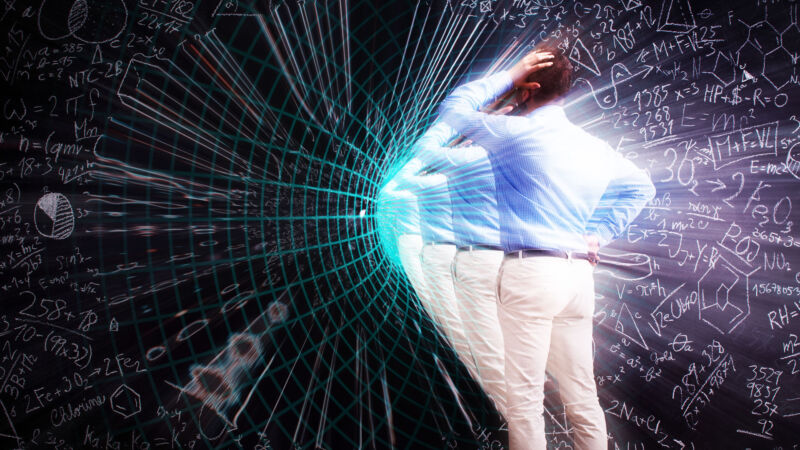
You’ve got yourself a fancy new spaceship and you want to start on a five-year tour of the galaxy. But there's a problem: Space is big. Really big. And even at the fastest speeds imaginable, it takes eons of crawling across the interstellar voids to get anywhere interesting.
The solution? It’s time to build a wormhole.
A shortcut. A tunnel. A bridge through spacetime that lets you skip through all that boring space travel and speed to the fun stuff. It’s a staple of science-fiction, and it’s rooted in science-fact. How difficult could it be?
Here’s a hint: incredibly difficult.
Option #1: The Einstein-Rosen Bridge
The first step is to understand that wormholes are totally legit in the mathematics of general relativity (GR). We’re using GR because that’s our language of gravity, and Albert Einstein’s brilliant mathematical engine is relatively straightforward. Einstein realized that while we experience gravity as a force, it's really just the sensation we feel as we’re forced to navigate the bumps, wiggles, and undulations of spacetime. Those same bumps, wiggles, and undulations come from the distribution of matter and energy in that same spacetime.
Matter tells spacetime how to bend; the bending of spacetime tells matter how to move.
If we want to build a tunnel in spacetime—a wormhole—we need to discover some arrangement of matter and/or energy that bends spacetime just so, ensuring that a tunnel will appear. With general relativity as a guide, we need to find a solution to its equations that permits the existence of a wormhole.
And at first glance, we might think that the simplest way to build a wormhole is to build a black hole.
Black holes are regions of spacetime that are cut off from the rest of the Universe. They are punctures in spacetime itself—a point of infinite density known as a singularity, wrapped in a one-way barrier called the event horizon. Once you cross the event horizon, the inrush of gravity is so overwhelming that nothing, not even light, can escape. Indeed, it’s more than a one-way trip; it’s a straight-up highway to a (singular) hell. Once you enter a black hole, you’re guaranteed to reach the singularity—and your doom—in a finite amount of time.
The black hole solution appears in GR as the answer to a very simple question: What happens when you squish matter down to such a high density that no other force is strong enough to counteract it? Boom—black hole.
But black holes are not the only answer to that question. The math of GR permits the complete opposite of a black hole, known affectionately as a white hole. White holes also have a singularity at the center, but their event horizons work in reverse—nothing can enter a white hole, and anything inside the white hole when it forms will quickly find itself flung outward faster than the speed of light.
What does all of this have to do with black holes? Looking at the bare math of GR, when you form a black hole, you automatically get a white hole attached to it. And a connected pair of black and white holes automatically forms a wormhole because of that same baked-in math.
These are called Einstein-Rosen Bridges (or, if you’re feeling fancy, a maximally extended Schwarzschild metric), after Einstein and his collaborator, Nathan Rosen. This solution appears in GR as plain as day.
Black hole blues
There are two small problems with this setup, however.
First, white holes almost certainly don’t exist. They are energetically highly unstable. The problem is the reverse-event horizon, which can never let anything in from the outside but constantly spews things out. Since a white hole is exactly equivalent to a black hole but runs backward in time, an evolving white hole would look like the formation of a black hole but in reverse: the white hole doing its thing until it loses enough mass and spontaneously forms a star.
You can’t spontaneously form a star just because you feel like it, because that would violate the second law of thermodynamics.
So white holes are out.
This means that if you try to leave the clean, sterilized condition of GR’s math behind and attempt to form a black hole in the real world, the white hole never really happens. All the material you would use to form the white hole strangles it in the womb using its own gravitational umbilical cord, cutting off its formation and leaving behind just the black hole.
If you were somehow able to construct a white/black hole pair, you would technically have a wormhole. It just wouldn’t be a very fun one.
The problem with Einstein-Rosen bridges is that the wormhole entrance itself sits within the event horizon of the black hole. You must pass through that one-way barrier to continue on your wormhole journey. But the very nature of the event horizon means you can't leave once you enter, and you will hit the singularity in the center no matter what.
This result comes from the same mathematics that permit the existence of the wormhole in the first place, so there’s no getting out of this trap.
Yes, someone could jump in from the other side, perhaps from a distant corner of the Universe. And you could meet and share a brief conversation before hitting the singularity. You could even hold hands as you reach annihilation.
reader comments
353